Facebook says that none of the up to 200 people that viewed a live stream of the Christchurch attack on the social media platform reported it.

The social media company, which is under pressure to change its live streaming practices in the wake of last Friday’s attack, also says it is using several techniques to keep the video off its platform now.
Facebook - and other social media operators - have faced stern criticism and political pressure over the past few days to prevent access to first-person video of the attack on two mosques in the New Zealand city.
The company said yesterday it had either deleted or killed upon upload about 1.5 million copies of the offending video.
It attempted to downplay the reach of the video when it initially live streamed, and said it had not been alerted to problems with the content until after the stream was over.
“The video was viewed fewer than 200 times during the live broadcast,” Facebook said.
“No users reported the video during the live broadcast. Including the views during the live broadcast, the video was viewed about 4000 times in total before being removed from Facebook.
“The first user report on the original video came in 29 minutes after the video started, and 12 minutes after the live broadcast ended.”
Facebook said it “removed the original Facebook Live video and hashed it so that other shares that are visually similar to that video are then detected and automatically removed from Facebook and Instagram.”
“Some variants such as screen recordings were more difficult to detect, so we expanded to additional detection systems including the use of audio technology,” the company said.
Hashing is often used to index still images or video to make it easier to recognise or compare them with over versions which might appear.
Researchers say the technique is commonly used by law enforcement.
“It is common for forensic practitioners to use databases of cryptographic hashes to search for known files. For example, some law enforcement organisations maintain databases of hash values of illegal images and videos. When media is obtained in a case, every file is cryptographically hashed and those hashes are compared to the hash database. Matches indicate the presence of a target file,” a 2015 paper says.
Facebook said it has “shared more than 800 visually-distinct videos related to the attack” with the Global Internet Forum to Counter Terrorism (GIFCT), which it said “coordinates regularly on terrorism” issues.
Internet providers in Australia and New Zealand are also temporarily blocking many sites hosting copies of the video.
However, they have called for Facebook and other social media operators to come to the table to work out a more permanent solution to recognising and revoking access to offensive content.



.png&h=140&w=231&c=1&s=0)

_(20).jpg&h=140&w=231&c=1&s=0)



_(26).jpg&w=100&c=1&s=0)

 iTnews Executive Retreat - Security Leaders Edition
iTnews Executive Retreat - Security Leaders Edition












_(1).jpg&h=140&w=231&c=1&s=0)



